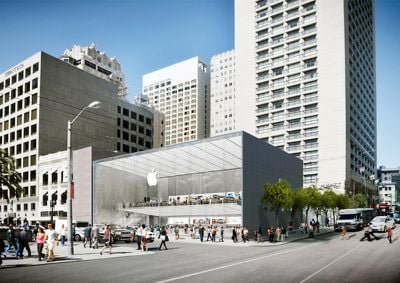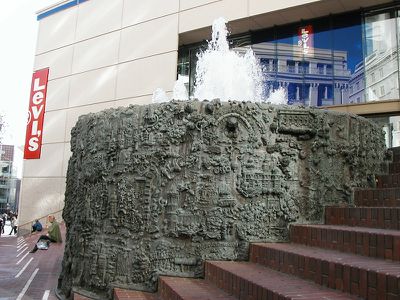Earlier this month, Apple filed plans for a relocated flagship retail store in San Francisco, proposing to close its existing store at 1 Stockton Street in favor of the new store three blocks north directly on Union Square. The filing was accompanied by a press release from city officials touting the project:
“Apple’s new store is quite simply incredible,” said Mayor Lee. “San Francisco is the Innovation Capital of the World, and I can think of no better location for the world’s most stunning Apple Store than right here in Union Square. I want to thank Apple for their investment in this City and continued commitment to growing jobs in San Francisco.”
“I’m excited that the company that revolutionized consumer technologies is moving to the heart of Union Square,” said President Chiu. “The new Apple store will highlight technology and design innovation as well as build community at the center of our City’s retail district.”

The proposed store's typical clean lines and heavy use of metal and glass immediately drew some criticism from observers, and San Francisco Chronicle urban design critic John King has now published a critique of Apple's plans highlighting some of the design considerations and the impact the construction will apparently have on an adjacent public plaza and sculptural fountain.
What's baffling is that a company renowned for design innovation has hired one of the world's most acclaimed architecture firms, only to unload a box that would look at home in Anymall, U.S.A.
Worse, it's a box that would displace one of downtown's friendliest works of public art, a bronze fountain by Ruth Asawa that - unlike the proposed polished Apple - could exist nowhere else but here.
King confirms that the architect on the proposed project is Foster + Partners, which has reportedly been taking on a greater role in Apple's retail projects since its involvement with Apple's upcoming new headquarters campus in Cupertino.
In his critique, King takes issue with the all-glass storefront on Post Street that will see direct sun exposure for much of the day, as well as the Stockton Street frontage that will simply be an 80 foot-long windowless wall. Apple's plans also call for a narrow stairway leading up to public plaza behind the store, a plaza that will be reduced from its current size and apparently see the removal of the popular fountain sculpture that has been in place for 40 years.
The fountain was also designed as the centerpiece of the existing triangular plaza along Stockton Street, wrapped in the upward ripple of brick steps. Passersby stop, look, take photographs and smile.
Apple, apparently, has different ideas. A study of the plans shows no sign of the fountain. The broad, inviting steps are gone.

King is not optimistic that the San Francisco Planning Department will require a significant redesign of the proposed project, considering the praise already heaped upon Apple's plans by city officials, but he does hope that some tweaks can be made that at the very least would improve the pedestrian experience along Stockton Street and the public plaza.
























